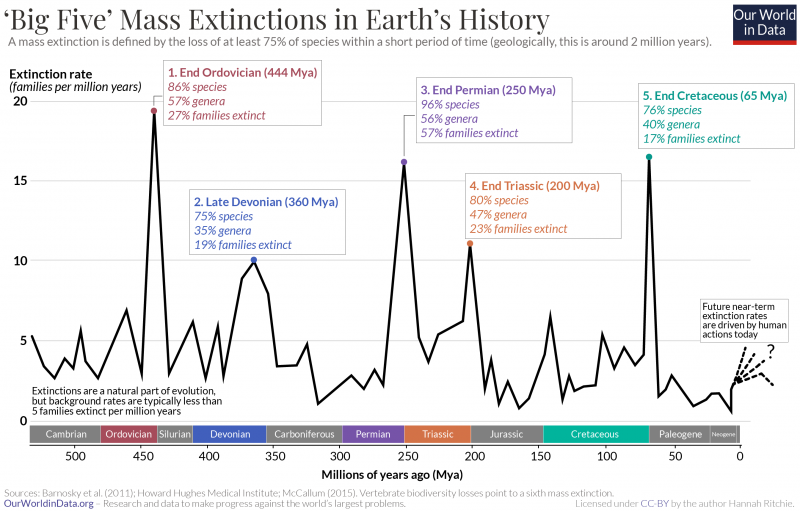There have been five big mass extinctions in Earth’s history – these are called the ‘Big Five’. Understanding the reasons and timelines of these events is important to understand the speed and scale of species extinctions today.
When and why did these mass extinction events happen?
What is a mass extinction?
First, we need to be clear on what we mean by ‘mass extinction’. Extinctions are a normal part of evolution: they occur naturally and periodically over time.1
There’s a natural background rate to the timing and frequency of extinctions: 10% of species are lost every million years; 30% every 10 million years; and 65% every 100 million years.2 It would be wrong to assume that species going extinct is out of line with what we would expect. Evolution occurs through the balance of extinction – the end of species – and speciation – the creation of new ones.
Extinctions occur periodically at what we would call the ‘background rate’. We can therefore identify periods of history when extinctions were happening much faster than this background rate – this would tell us that there was an additional environmental or ecological pressure creating more extinctions than we would expect.
But mass extinctions are defined as periods with much higher extinction rates than normal. They are defined by both magnitude and rate. Magnitude is the percentage of species that are lost. Rate is how quickly this happens. These metrics are inevitably linked, but we need both to qualify as a mass extinction.
In a mass extinction at least 75% of species go extinct within a relatively (by geological standard) short period of time.3 Typically less than two million years.
The ‘Big Five’ mass extinctions
There have been five mass extinction events in Earth’s history. At least, since 500 million years ago; we know very little about extinction events in the Precambrian and early Cambrian earlier which predates this.4 These are called the ‘Big Five’, for obvious reasons.
In the chart we see the timing of events in Earth’s history.5 It shows the changing extinction rate (measured as the number of families that went extinct per million years). Again, note that this number was never zero: background rates of extinction were low – typically less than 5 families per million years – but ever-present through time.
We see the spikes in extinction rates marked as the five events:
- End Ordovician (444 million years ago; mya)
- Late Devonian (360 mya)
- End Permian (250 mya)
- End Triassic (200 mya) – many people mistake this as the event that killed off the dinosaurs. But in fact, they were killed off at the end of the Cretaceous period – the fifth of the ‘Big Five’.
- End Cretaceous (65 mya) – the event that killed off the dinosaurs.
Finally, at the end of the timeline we have the question of what is to come. Perhaps we are headed for a sixth mass extinction. But we are currently far from that point.
There are a range of trajectories that the extinction rate could take in the decades and centuries to follow; which one we follow is determined by us.

What caused the ‘Big Five’ mass extinctions?
All of the ‘Big Five’ were caused by some combination of rapid and dramatic changes in climate, combined with significant changes in the composition of environments on land or in the ocean (such as ocean acidification or acid rain from intense volcanic activity).
In the table here I detail the proposed causes for each of the five extinction events.6
| Extinction Event | Age(mya) | Percentage of species lost | Cause of extinctions |
| End Ordovician | 444 | 86% | Intense glacial and interglacial periods created large swings in sea levels and moved shorelines dramatically. Tectonic uplift of the Appalachian mountains created lots of weathering, sequestration of CO2 and with it, changes in climate and ocean chemistry. |
| Late Devonian | 360 | 75% | Rapid growth and diversification of land plants generated rapid and severe global cooling. |
| End Permian | 250 | 96% | Intense volcanic activity in Siberia. This caused global warming. Elevated CO2 and sulphur (H2S) levels from volcanoes caused ocean acidification, acid rain, and other changes in ocean and land chemistry. |
| End Triassic | 200 | 80% | Underwater volcanic activity in the Central Atlantic Magmatic Province (CAMP) caused global warming, and a dramatic change in chemistry composition in the oceans. |
| End Cretaceous | 65 | 76% | Asteroid impact in Yucatán, Mexico. This caused global cataclysm and rapid cooling. Some changes may have already pre-dated this asteroid, with intense volcanic activity and tectonic uplift. |

